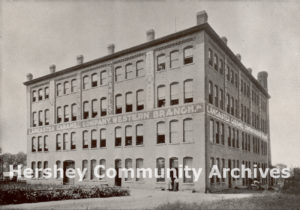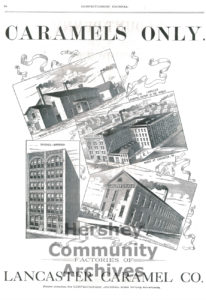Lancaster Caramel Company

Milton Hershey started the Lancaster Caramel Company in 1886 after he returned to Lancaster, Pennsylvania following the failure of his New York City candy business. The Lancaster business would be his third confectionery venture. The new business was first located in Jacob Gable’s big warehouse on the west side of South Duke Street near Vine Street. However, the facilities were unsuitable lacking a boiler to cook the caramels. Hershey soon moved to an old factory building on Church Street. The factory had once housed the Edison Electric Plant and now was home to a variety of businesses including a carriage maker’s shop, a carpet beating business and a piano and organ manufacturer.
The early months were a struggle. Bank credit to purchase raw ingredients was difficult to obtain. Milton Hershey had returned to Lancaster with a bad credit rating due to his failed New York business. He had little to offer for collateral other than some cooking kettles in a rented facility in a questionable part of town. Help came when Hershey needed it most from the cashier at the Lancaster County National Bank. Hershey had received a large order for his milk caramels from a British candy importer, known today only by his cable address, “DECIES” and Hershey needed to borrow money to purchase raw ingredients to fulfill the order. The bank’s cashier was so impressed by Milton Hershey that he lent him the money, backing the loan with his own signature. When Milton Hershey received payment for the candy order he was so excited that he ran down the street to the bank with his apron still on.
That order marked a turning point for the Lancaster Caramel Company. The business began to grown rapidly and Hershey expanded into other parts of the factory building as tenants vacated. By 1890 he occupied the entire building. He soon expanded down the street. On November 10, 1891 he purchased from his Aunt Mattie 347 Church Street, a small house she had purchased a year earlier. This dwelling’s address became the Company’s main office address. Other adjoining properties were bought piece by piece until Lancaster Caramel Company extended 301 feet along Church Street and 207 feet back to Howard Avenue (then Middle Street), containing 450,000 square feet of floor space.
Still needing more factory space, Milton Hershey expanded the company outside of Lancaster. In 1891 he acquired three lots and a small factory in Mount Joy, Pennsylvania and the new factory soon began caramel production.
In 1892, Lancaster Caramel Company expanded westward. One of the Lancaster Caramel Company’s competitors could offer its western customers lower shipping prices because their factory was located in the midwest. Hershey responded to the competition by building a factory in Illinois. The Lancaster Caramel Company’s Western Branch was located on West Harrison Street in Chicago. The Western Branch operated from that location for two and one-half years before it moved to a larger, more conveniently located factory in Bloomington, Illinois. The Bloomington factory operated until 1900 when it was sold to the Paul F. Beich Company.
Shortly after establishing the Western Branch, Hershey set up a third caramel factory in Reading, Pennsylvania. The factory was located in a building on Penn Street that had last functioned as a cabaret, Groff’s Tropical Gardens.. After the factory burned down in 1899 the business moved to a site on Mifflin Street, between Spruce and Pine Streets.
Hershey’s caramels were manufactured under the “Crystal A” trademark. The Lancaster Caramel Company product line included different grades of caramels priced for different markets. They ranged from bean-shaped MCGINTYs that sold to children at the rate of ten for a penny, medium-grade ROLY POLY, to the top grade LOTUS. These top of the line caramels were made with sugar, corn syrup, fresh whole milk and 40% cream, together with almonds, a little cocoa powder, and a taste of chocolate. The inch-square LOTUSES sold to the trade in a five pound box for a dollar. The Lancaster Caramel Company product line was extensive. Other products included:
- HOBSON KISSES – made with sugar, corn syrup, and a little milk
- PARADOX– highest quality product line
- COCANUT ICES– highest quality product line
- UNIQUE – Budget product line; narrow strips; selling 8 for a penny
- ICELTS – Made with skim milk. Machine molded in a bean shape; hand iced
- MELBA – Made with skim milk
- EMPIRE – Made with skim milk
By 1894 Milton Hershey was considered one of Lancaster’s most substantial citizens. The 1894 issue of the Lancaster County Portrait and Biographical Record printed this description:
Milton S. Hershey is the president of a caramel company that employs eight hundred hands in Lancaster, a hundred in Mt. Joy, a hundred in Geneva, Illinois and four hundred in the Chicago factory. The original business was started in the city of Lancaster and it has gown to wonderful proportions. The machinery employed is of their own invention and is all covered by patents. Their trademark is “Crystal A.” These goods are shipped to all parts of the world, including Japan, China, Australia and Europe. The capital stock is $600,000, all paid up, and they do over $1,000,000 worth of business per annum.
The Lancaster Caramel Company was incorporated on February 8, 1894. It was at this time that Hershey Chocolate Company was formally organized as a subsidiary of the Lancaster Caramel Company. Stock was issued to a small group of men as part of the legal requirements of incorporation. Milton Hershey, of course, owned the majority of the stock. Other holders included: William. L. Blair, Edward M. Robinsion, Carl Kleinbeck, of Chicago, and Frank B. Snavely, of Chicago. The Hershey Chocolate Company was listed as a subsidiary of the Caramel Company. When Milton Hershey sold the Lancaster Caramel Company on August 10, 1900 to the American Caramel Company for $1 million, he retained the rights to the Hershey Chocolate Company.

